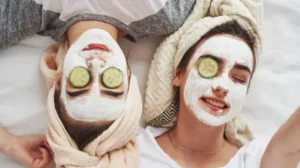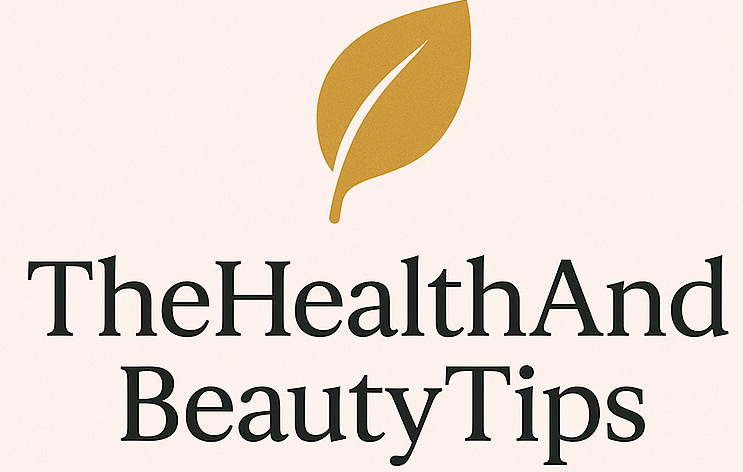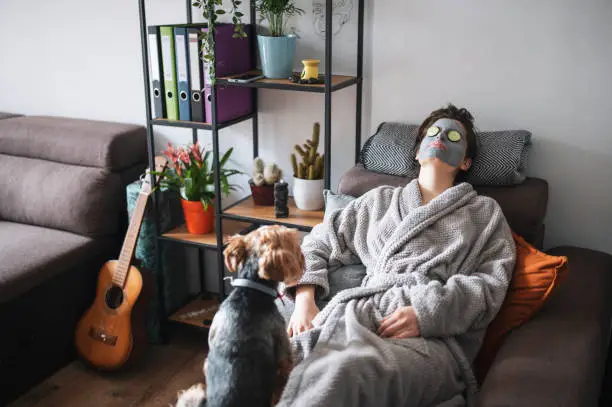Face treatments at home
Taking care of your skin is essential for maintaining a healthy, glowing complexion, and you don’t always need to visit a salon or dermatologist to achieve the best results. With the right tools, products, and techniques, you can perform effective face treatments at home.
we will explore some of the best face treatments you can do at home, including homemade masks, routines, tools, and tips for different skin types and concerns.
Why At-Home Face Treatments Are Popular
There are several reasons why more and more people are turning to at-home face treatments:
Cost-Effective: Professional spa treatments or dermatologist visits can be expensive. Doing your treatments at home can save you money in the long run.
Convenience: You can perform a skincare routine or treatment anytime you wish, in the comfort of your home, without needing an appointment.
Customization: You can tailor at-home treatments to your specific skin needs. Whether you have dry skin, oily skin, acne, or signs of aging, you can use products and techniques that are best suited for your skin type.
Privacy and Comfort: There’s no need to feel rushed or uncomfortable in a spa or clinic environment. You can unwind and enjoy the process without feeling self-conscious.
No Downtime: Many in-office treatments come with recovery periods or potential side effects, but at-home skincare often has minimal risk, allowing you to continue your routine without interruption.
Basic Steps for a Skincare Routine at Home
Before diving into specific face treatments, it’s important to have a solid foundation in your daily skincare routine. Here’s a basic guide to help you get started:
Cleansing
Cleanse your face twice a day to remove dirt, oil, and makeup. Use a gentle cleanser that suits your skin type (gel, cream, or oil-based).
Exfoliating
Exfoliate your skin 1-3 times per week, depending on your skin’s tolerance. This step helps remove dead skin cells and reveals a brighter complexion. Choose an exfoliator that suits your skin type.
Toning
Toning helps restore your skin’s pH balance and can remove any remaining impurities after cleansing. Look for a toner that suits your skin concerns, such as hydrating, soothing, or clarifying toner.
Treatment (Serums and Masks)
Serums are concentrated formulas designed to target specific skin concerns like dark spots, wrinkles, or acne. Masks can offer a quick boost to your skin, delivering intense hydration, exfoliation, or brightening in one treatment.
Moisturizing
Moisturizing keeps your skin hydrated and ensures that it doesn’t dry out. Even oily skin types need moisturizer—just choose a lightweight formula that doesn’t clog pores.
Sunscreen
The most important step in your skincare routine is wearing sunscreen daily. UV rays are one of the biggest culprits in premature aging and skin damage, so always use SPF 30 or higher, even on cloudy days.
Top Face Treatments You Can Do at Home

Now that you understand the basics of a skincare routine, let’s look at some of the most popular face treatments that can be easily done at home.
Hydrating Face Masks
A hydrating face mask is one of the best treatments for dry skin. These masks provide deep moisture and help replenish your skin’s natural barrier.
DIY Hydrating Face Mask Recipe:
- Ingredients: 1 tablespoon honey, 1 tablespoon aloe vera gel, 2 teaspoons yogurt
- Instructions: Mix all ingredients and apply to your face for 15-20 minutes. Rinse off with lukewarm water.
Honey is a natural humectant, meaning it draws moisture to the skin, while aloe vera is calming. Yogurt contains lactic acid, which gently exfoliates and helps hydrate the skin.
Brightening Face Masks
Brightening face masks are great for those with dull, uneven skin tones or hyperpigmentation. These masks often include ingredients like vitamin C, turmeric, or lemon juice, which can help even out skin tone and add radiance.
DIY Brightening Face Mask Recipe:
- Ingredients: 1 tablespoon turmeric, 2 teaspoons honey, 1 tablespoon milk
- Instructions: Mix turmeric and honey, then add milk to form a paste. Apply it to your face for 10-15 minutes. Rinse with lukewarm water.
Turmeric has anti-inflammatory properties and can reduce skin redness or irritation. Honey and milk are known for their moisturizing benefits, while milk helps brighten your complexion.
Acne-Fighting Face Treatments
Acne is one of the most common skin issues people face, but there are several effective treatments you can do at home to help manage breakouts.
DIY Acne Mask Recipe:
- Ingredients: 2 tablespoons green tea (cooled), 1 tablespoon honey, 1 tablespoon lemon juice
- Instructions: Mix all ingredients and apply the mixture to your face. Leave on for 10-15 minutes, then rinse.
Green tea is rich in antioxidants and has anti-inflammatory properties, which help reduce redness and swelling associated with acne. Honey is known for its antibacterial qualities, and lemon juice helps reduce oil buildup.
Anti-Aging Face Treatments
If you’re looking to tackle fine lines and wrinkles, there are numerous ingredients you can incorporate into your at-home treatments.
DIY Anti-Aging Mask Recipe:
- Ingredients: 1/2 ripe avocado, 1 tablespoon honey, 1 tablespoon yogurt
- Instructions: Mash the avocado and mix with honey and yogurt. Apply to your face for 15-20 minutes, then rinse with warm water.
Avocado is rich in healthy fats and vitamins E and C, which help nourish the skin and fight wrinkles. Honey and yogurt provide additional moisturizing and soothing benefits.
Exfoliating Treatments
Exfoliating helps to remove dead skin cells, leaving your face feeling smooth and fresh. There are two types of exfoliants: physical (scrubs) and chemical (AHA/BHA acids).
DIY Exfoliating Scrub Recipe:
- Ingredients: 2 tablespoons ground coffee, 1 tablespoon honey, 1 tablespoon coconut oil
- Instructions: Mix all ingredients and massage gently onto damp skin in circular motions for 2-3 minutes. Rinse off with warm water.
Coffee grounds are a great physical exfoliant that helps remove dead skin cells, while honey and coconut oil provide hydration and skin barrier protection.
Steam Treatments
Steaming your face is a simple yet effective treatment to open up pores and deeply cleanse your skin.
How to Steam Your Face at Home:
- Boil water and pour it into a large bowl.
- Drape a towel over your head and lean over the bowl, allowing the steam to open your pores for about 10 minutes.
- After steaming, apply a hydrating mask or serum to lock in moisture.
Steaming can help release trapped dirt and oils, making it easier to extract impurities from the skin. It also helps increase blood circulation, which can contribute to a healthy glow.
Facial Massage
A facial massage can help promote circulation, reduce tension, and boost the absorption of skincare products.
How to Perform a Facial Massage:
- Apply your favorite serum or oil to your face.
- Using your fingertips, start massaging your forehead in upward and outward motions.
- Move to your cheeks, jawline, and neck, using gentle, upward strokes.
- Finish with a few minutes of light tapping to stimulate circulation.
Facial massage can help reduce puffiness, increase skin elasticity, and relieve tension in the face, which can help reduce the appearance of wrinkles.
Face Rolling with Jade or Rose Quartz Rollers

Facial rollers made of jade or rose quartz are often used for their cooling and soothing effects. They help to reduce puffiness, smooth the skin, and promote relaxation.
How to Use a Facial Roller:
- Begin with a clean face and apply your serum or oil.
- Start at the center of your face, using gentle, upward strokes to roll the tool along your forehead, cheeks, and neck.
- Use the roller for about 5-10 minutes daily to help with lymphatic drainage and reduce swelling.
Taking care of your skin at home is both rewarding and effective. With the right ingredients, tools, and techniques, you can create a skincare routine that addresses your specific concerns, whether it’s acne, aging, dryness, or dullness. Always remember to listen to your skin and adjust your routine based on how your skin responds.
Can face masks replace a full skincare routine?
No, face masks cannot replace a full skincare routine. While face masks offer concentrated benefits for your skin—like hydration, exfoliation, or brightening—they are designed to be a supplement to your regular skincare routine, not a replacement.
Here’s why:
Daily Cleansing
Cleansing your face daily is essential for removing dirt, oil, and impurities that accumulate throughout the day. Face masks are not intended to cleanse your skin. A proper cleanser is necessary to ensure your skin is clean and free from makeup, pollution, and excess oils before applying other skincare products.
Toner and Treatment Products
Toners help to balance your skin’s pH and remove any remaining residue after cleansing. They also prep the skin for treatments like serums, which are often designed to target specific skin concerns (e.g., acne, wrinkles, pigmentation). Face masks typically don’t provide the same benefits as toner or treatment products, and you wouldn’t want to skip these steps, especially if you’re addressing specific issues.
Moisturizing
After cleansing and applying serums, a good moisturizer helps lock in hydration and keeps your skin’s moisture barrier intact. Face masks provide temporary hydration, but they cannot replace the ongoing moisture that your skin needs throughout the day or night. Without a moisturizer, your skin may become dry or irritated.
Sun Protection
Sunscreen is a vital part of your skincare routine, especially during the daytime. UV rays can cause long-term damage to the skin, including premature aging and pigmentation. Face masks, no matter how hydrating or nourishing, do not protect your skin from the sun. Sunscreen is a must-have step in your daily routine to keep your skin safe.
Consistency
Skincare routines involve consistent use of products that address your skin’s unique needs over time. While face masks provide a quick boost, they can’t offer the same continuous benefits as daily products like cleansers, serums, and moisturizers, which work in synergy to improve the health of your skin.
Conclusion
Face masks can enhance and improve your skin, but they should be seen as an addition to your skincare regimen rather than a substitute. To maintain healthy, glowing skin, it’s important to follow a consistent routine of cleansing, treating, moisturizing, and protecting, in addition to occasional face masks for that extra skincare boost.
FAQ (Frequently Asked Questions)
- How often should I do face treatments at home? You can perform a full face treatment once or twice a week, depending on the intensity. Regular skin care routines, like cleansing and moisturizing, should be done daily.
- Are at-home face treatments safe? Yes, as long as you use the correct products for your skin type and follow proper techniques. Always patch-test new ingredients to ensure you don’t have an allergic reaction.
- Can I use essential oils for at-home face treatments? Yes, but be cautious. Essential oils should always be diluted in carrier oil before applying to your skin. Some essential oils, like lavender and tea tree oil, are beneficial for acne or relaxation.
- How do I know my skin type? To determine your skin type, cleanse your face and wait for an hour. If your skin feels tight, it’s likely dry. If it’s oily in the T-zone (forehead, nose, chin), you have combination skin. If it’s oily all over, your skin is oily. If it’s neither dry nor oily, you likely have normal skin.
- Can face masks replace a full skincare routine? Face masks are a supplement to your regular skincare routine, not a replacement. While they provide added benefits like hydration or exfoliation, you still need to cleanse, tone, and moisturize daily.
- How can I target specific skin concerns at home? You can target specific concerns like acne, wrinkles, or dryness by selecting treatments that feature ingredients known for addressing these issues. For acne, opt for products with salicylic acid or tea tree oil. For anti-aging, look for products with retinol or peptides.

